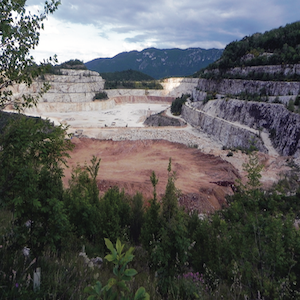Spontaneous renaturalization of open ecosystems in the hills of Brescia seen through the bird community

Accepted: 17 May 2023
All claims expressed in this article are solely those of the authors and do not necessarily represent those of their affiliated organizations, or those of the publisher, the editors and the reviewers. Any product that may be evaluated in this article or claim that may be made by its manufacturer is not guaranteed or endorsed by the publisher.
Authors
The sun-exposed open areas of the Brescia hills overlooking the Po Valley (Avanalpica region) were created by man starting from the 11th century. After the Second World War, following agro-pastoral abandonment, these areas have significantly shrunk. The evolution underway is towards the deciduous forest although in some areas the strong presence of quarries is blocking the vegetational succession or delaying it. Local birds are now largely associated with woodland coenosis and more scarcely with open areas, shrublands and wood edges. Seven open areas species have become extinct over the past 30 years: Woodchat Shrike, Barred Warbler, Rufous-tailed Rock-Thrush, Eastern Black-eared Wheatear, Tawny Pipit, Corn Bunting and Ortolan Bunting. Others, like Red-backed Shrike, Common Whitethroat, Cirl Bunting and Wood Lark have declined. Only the generalist Sardinian Warbler and Blue Rock-Thrush, typical of rocky areas with grassy spaces, are still relatively widespread although slightly decreasing. The Cirl Bunting, a species linked to traditional vineyards and orchards, is not expanding in the new intensively cultivated lands. The Eastern Subalpine Warbler is on the rise even though, due to its very low presence and lack of specific surveys, it may not have been detected in the past. The factors determining the presence of these species, i.e. traditional crops, flat open areas, soils with low grass and often with outcropping and/or rocky substrate, are in sharp decline. We can state that this bird community is negatively influenced by the percentage of tree cover and positively influenced by the presence of quarries which, however, represent an ephemeral and strongly impacting environment. In the absence of fires and/or natural disasters as well as human interventions, which are not likely to occur due to their poor economic sustainability, the prognosis for these birds is to be considered poor and a reduction in both bird and general biodiversity is to be expected.
Downloads
Citations
PlumX Metrics
PlumX Metrics provide insights into the ways people interact with individual pieces of research output (articles, conference proceedings, book chapters, and many more) in the online environment. Collectively known as PlumX Metrics, these metrics are divided into five categories to help make sense of the huge amounts of data involved and to enable analysis by comparing like with like.
How to Cite

This work is licensed under a Creative Commons Attribution-NonCommercial 4.0 International License.
PAGEPress has chosen to apply the Creative Commons Attribution NonCommercial 4.0 International License (CC BY-NC 4.0) to all manuscripts to be published.
Similar Articles
- Paolo Marotto, Hybrids of Aythya: unusual concentration on the Po river in Turin (NW Italy) , Rivista Italiana di Ornitologia: Vol. 82 No. 1-2 (2012)
- Giovanni Salvo, [Density of Lesser Kestrel Falco naumanni in centralsouthern Sicily (Italy)] , Rivista Italiana di Ornitologia: Vol. 88 No. 2 (2018)
- Nicola Baccetti, Birds of Libya / Oiseaux de Libye , Rivista Italiana di Ornitologia: Vol. 87 No. 2 (2017)
- Carlo Giannella, Guido Baroni, Giovanni Tosatti, Lorenzo Tosatti, Time-budget of dabbling ducks migrating through Modena province in springtime , Rivista Italiana di Ornitologia: Vol. 82 No. 1-2 (2012)
- Grzegorz Kopij, The role of peri-urban wetland and meadow habitats in the protection of trans-Saharan migrant passerine species in a central European city , Rivista Italiana di Ornitologia: Vol. 88 No. 1 (2018)
- Corrado Battisti, Mapping breeding birds in a re-naturalized historical fortress: composition, structure and considerations about abundance vs. biomass comparisons , Rivista Italiana di Ornitologia: Vol. 93 No. 2 (2023)
- Luca Maurino, The Ptarmigan, Lagopus mutus, in the Natural Park Val Troncea (Piedmont Region) , Rivista Italiana di Ornitologia: Vol. 82 No. 1-2 (2012)
- Giovanni Boano, Fabio Perco, Marco Pavia, Natale Emilio Baldaccini, [Columba livia domestic breed, invasive entity also alien for Italy] , Rivista Italiana di Ornitologia: Vol. 88 No. 2 (2018)
- Maurizio Chiereghin, Alessandro Prezzi, Fabiano Sartirana, ERRATUM. Update on successful nesting of bearded vulture (Gypaetus barbatus) in the Lanzo Valleys, Piedmont region (NW Italy) , Rivista Italiana di Ornitologia: Vol. 94 No. 1 (2024)
- Bruno Santucci, Andrea Pulvirenti, Samuele Ramellini, Marinella Miglio, Habitat use during post-pre-breeding period in a Rock Sparrow Petronia petronia population , Rivista Italiana di Ornitologia: Vol. 89 No. 2 (2019)
<< < 5 6 7 8 9 10 11 12 13 14 > >>
You may also start an advanced similarity search for this article.


 https://doi.org/10.4081/rio.2023.667
https://doi.org/10.4081/rio.2023.667



